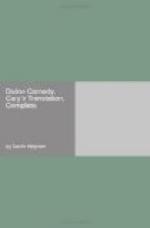v. 135. Those bright eyes.] The eyes of Beatrice.
CANTO XXVIII
v. 11. To that part.] The west.
v. 14. The feather’d quiristers] Imitated by Boccaccio, Fiammetta, 1. iv. “Odi i queruli uccelli,” &c. —“Hear the querulous birds plaining with sweet songs, and the boughs trembling, and, moved by a gentle wind, as it were keeping tenor to their notes.”
v. 7. A pleasant air.] Compare Ariosto, O. F. c. xxxiv. st. 50.
v. Chiassi.] This is the wood where the scene of Boccaccio’s sublimest story is laid. See Dec. g. 5. n. 8. and Dryden’s Theodore and Honoria Our Poet perhaps wandered in it daring his abode with Guido Novello da Polenta.
v. 41. A lady.] Most of the commentators suppose, that by this lady, who in the last Canto is called Matilda, is to be understood the Countess Matilda, who endowed the holy see with the estates called the Patrimony of St. Peter, and died in 1115. See G. Villani, 1. iv. e. 20 But it seems more probable that she should be intended for an allegorical personage.
v. 80. Thou, Lord hast made me glad.] Psalm xcii. 4
v. 146. On the Parnassian mountain.] In bicipiti somniasse Parnasso. Persius Prol.
CANTO XXIX
v. 76. Listed colours.] Di sette liste tutte in quel colori, &c. —a bow Conspicuous with three listed colours gay. Milton, P. L. b. xi. 865.
v. 79. Ten paces.] For an explanation of the allegorical meaning of this mysterious procession, Venturi refers those “who would see in the dark” to the commentaries of Landino, Vellutello, and others: and adds that it is evident the Poet has accommodated to his own fancy many sacred images in the Apocalypse. In Vasari’s Life of Giotto, we learn that Dante recommended that book to his friend, as affording fit subjects for his pencil.
v. 89. Four.] The four evangelists.
v. 96. Ezekiel.] Chap. 1. 4.
v. 101. John.] Rev. c. iv. 8.
v. 104. Gryphon.] Under the Gryphon, an imaginary creature, the forepart of which is an eagle, and the hinder a lion, is shadowed forth the union of the divine and human nature in Jesus Christ. The car is the church.
v. 115. Tellus’ prayer.] Ovid, Met. 1. ii. v. 279.
v. 116. ’Three nymphs.] The three evangelical virtues: the first Charity, the next Hope, and the third Faith. Faith may be produced by charity, or charity by faith, but the inducements to hope must arise either from one or other of these.
v. 125. A band quaternion.] The four moral or cardinal virtues, of whom Prudence directs the others.
v. 129. Two old men.] Saint Luke, characterized as the writer of the Arts of the Apostles and Saint Paul.
v. 133. Of the great Coan.] Hippocrates, “whom nature made for the benefit of her favourite creature, man.”




